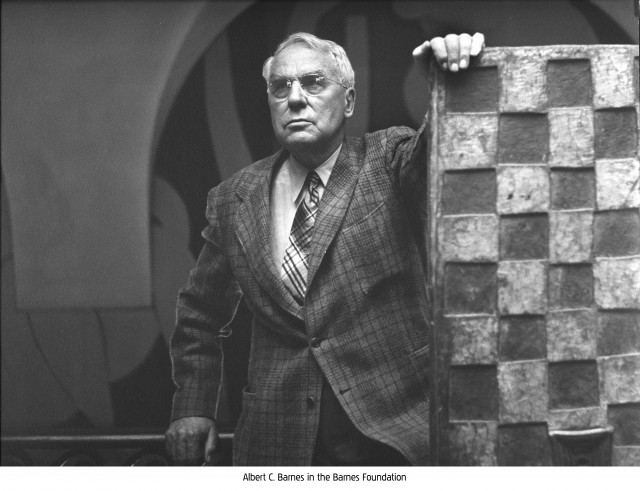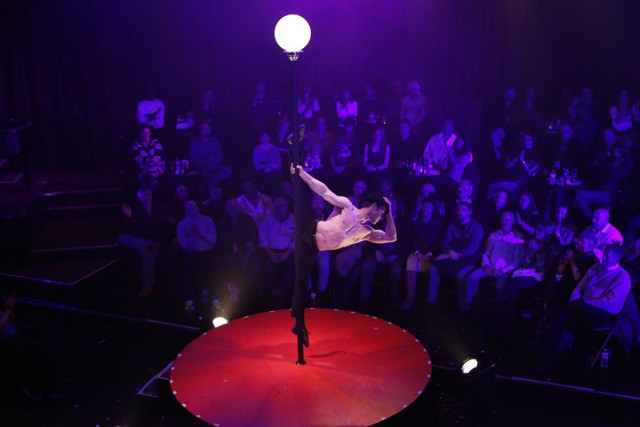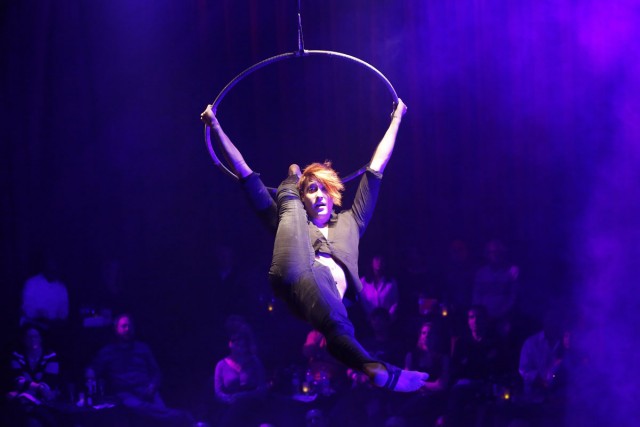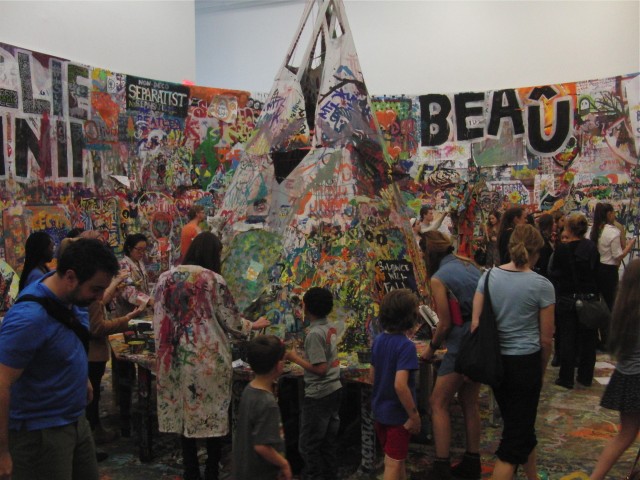
Visitors can contribute to “Draftsmen’s Congress” through Sunday, then take a piece home with them April 23-27 (photo by twi-ny/mdr)
New Museum of Contemporary Art
235 Bowery at Prince St.
Second & fourth floors: Wednesday – Sunday through April 20, $16
Thursday, April 17, 11:00 am – 9:00 pm: one-day exhibition of new sculptures, 231 Bowery, free
April 23-27, “Draftsmen’s Congress” disassembled and distributed to public for free
212-219-1222
www.newmuseum.org
The work of Polish artist Paweł Althamer is very much about collaboration, cooperation, and community, fostering a positive sense of togetherness and sharing without getting treacly. As his first U.S. museum retrospective, “Paweł Althamer: The Neighbors,” winds down at the New Museum, Althamer still has a few surprises in store, as he says in the exhibition catalog, “to share the experience of what we are doing — to see people doing one thing together. . . . The idea is to switch the rules of the game a little so that everybody is included.” Since the show opened back in February, museum visitors and local organizations have been contributing in its evolution, painting on the walls and floors in the participatory, palimpsestual “Draftsmen’s Congress.” The painting will come to a stop on Easter Sunday, but that’s not the end of the piece; from April 23 to 27, the work will be disassembled, cut into pieces, and handed out to visitors free of charge, furthering Althamer’s democratization not only of the creation of art but of its ownership. On April 17, Althamer, whom Joanna Mytkowska’s catalog essay calls “The People’s Artist,” has collaborated with Dogon sculptor Youssouf Dara, the Bowery Mission, and other neighbors for a free one-day exhibition that will be held in the New Museum’s next-door space at 231 Bowery. (Dara’s work can also be seen in the museum’s window display.)
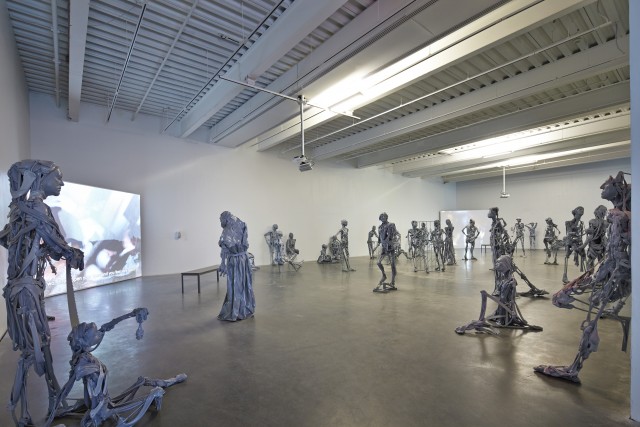
Paweł Althamer’s “Venetians” mix with visitors on the second floor (Courtesy New Museum, New York. Photo: Benoit Pailley)
In addition, the second floor of “The Neighbors” will remain on view through April 20, where museumgoers can walk among dozens of Althamer’s “Venetians,” gray, life-size steel-and-plastic skeletal sculptures of strangers he encountered in the Italian city and made face casts of, with a specific focus on those who often find themselves excluded or marginalized in one way or another. “It’s about being with them and identifying with them,” Althamer tells cocurator Massimiliano Gioni in the catalog. “People are generally scared of outsiders, but if we can confront and then lose our fear, it’s fantastic.” It’s no accident that the figures, which have gathered around eight video screens showing Althamer’s “So-Called Waves and Other Phenomena of the Mind,” in which he films himself in various altered mental states, have an alienlike quality. (The third floor, which closed April 13, featured many sculptural portraits, which he refers to as “totems,” of the artist himself and members of his family, as well as the miniature landscape “Mezalia” and an accompanying film.) Social collaboration is at the heart of Althamer’s practice, and that extends even to museum admission, as visitors can get in free if they bring a new or gently used men’s coat, which will be donated to the Bowery Mission.
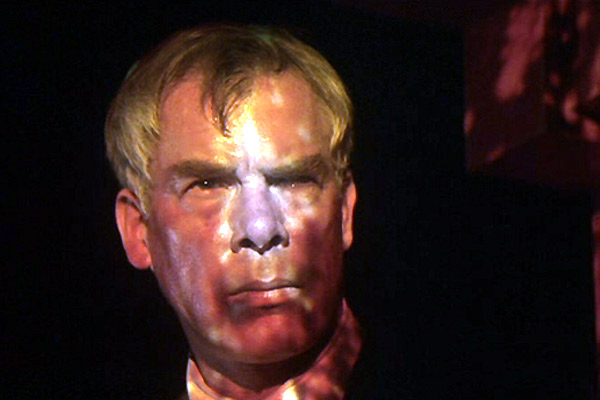
 John Boorman’s Point Blank is an oxymoronic psychedelic film noir, a violent psychological thriller about a determined man dead set on vengeance. Lee Marvin — on quite a hot streak following Cat Ballou, Ship of Fools, The Professionals, and The Dirty Dozen — stars as the one-named Walker, a sincere, old-fashioned man who is double-crossed by his wife, Lynne (Sharon Acker), and friend, Mal Reese (John Vernon, in his film debut), when a deal goes bad on Alcatraz. Searching for Reese, Walker hooks up with Lynne’s sister, Chris (Angie Dickinson), a sexy femme fatale who owns a hot club in the Bay Area. As Walker makes his way up the criminal organization ladder in his quest to get the $93,000 he’s owed, he leaves behind a bloody trail that keeps getting messier and messier. Adapted by Alexander Jacobs and David and Rafe Newhouse from Donald Westlake’s first Parker novel, The Hunter, Boorman’s film is like the antihero Walker himself, purposefully out of time and place. Walker is essentially an anachronism as he makes his way through Point Blank, evoking John Wayne’s Ethan Edwards in John Ford’s classic Western The Searchers. The Summer of Love seems to have had no effect on Walker, who still primarily dresses in dull colors — until Chris brings out the color in him, particularly in one memorable scene in which they both are wearing bright yellow and spy on Reese’s hideaway through a yellow telescope. Film noir is by definition set in a black-and-white world, but Walker can’t hide from the old ways anymore, as he shows when groovy colored lights flash on him in Chris’s club.
John Boorman’s Point Blank is an oxymoronic psychedelic film noir, a violent psychological thriller about a determined man dead set on vengeance. Lee Marvin — on quite a hot streak following Cat Ballou, Ship of Fools, The Professionals, and The Dirty Dozen — stars as the one-named Walker, a sincere, old-fashioned man who is double-crossed by his wife, Lynne (Sharon Acker), and friend, Mal Reese (John Vernon, in his film debut), when a deal goes bad on Alcatraz. Searching for Reese, Walker hooks up with Lynne’s sister, Chris (Angie Dickinson), a sexy femme fatale who owns a hot club in the Bay Area. As Walker makes his way up the criminal organization ladder in his quest to get the $93,000 he’s owed, he leaves behind a bloody trail that keeps getting messier and messier. Adapted by Alexander Jacobs and David and Rafe Newhouse from Donald Westlake’s first Parker novel, The Hunter, Boorman’s film is like the antihero Walker himself, purposefully out of time and place. Walker is essentially an anachronism as he makes his way through Point Blank, evoking John Wayne’s Ethan Edwards in John Ford’s classic Western The Searchers. The Summer of Love seems to have had no effect on Walker, who still primarily dresses in dull colors — until Chris brings out the color in him, particularly in one memorable scene in which they both are wearing bright yellow and spy on Reese’s hideaway through a yellow telescope. Film noir is by definition set in a black-and-white world, but Walker can’t hide from the old ways anymore, as he shows when groovy colored lights flash on him in Chris’s club.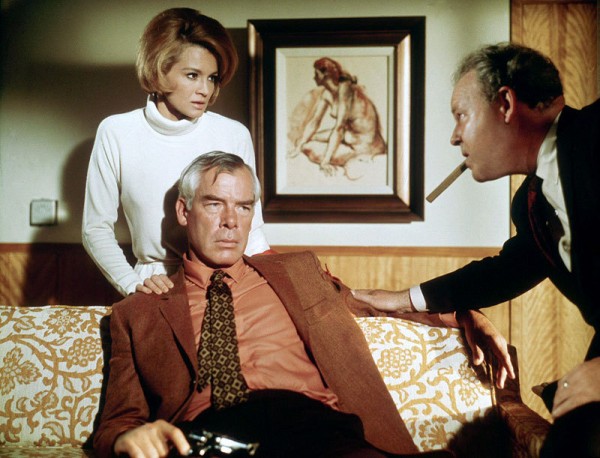
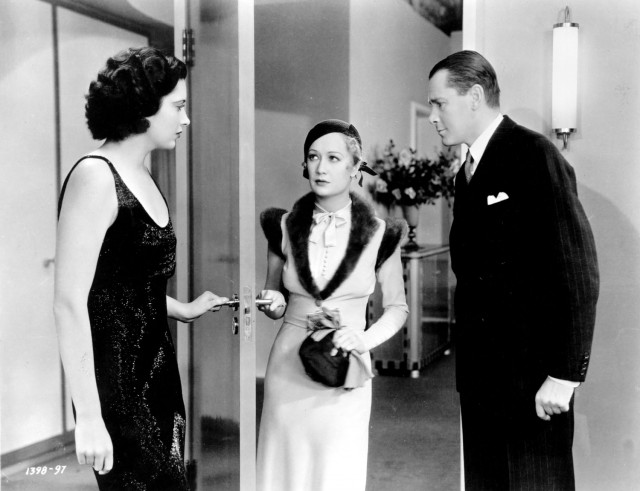
 “Beginnings are always difficult,” suave thief Gaston Monescu (Herbert Marshall) says at the beginning of Trouble in Paradise, but it’s not difficult at all to fall in love with the beginning, middle, and end of Ernst Lubitsch’s wonderful pre-Code romantic comedy. It’s love at first heist for Gaston and Lily (Miriam Hopkins) as they try to outsteal each other on a moonlit night in Venice. Soon they are teaming up to fleece perfume heir Madame Mariette Colet (Kay Francis) of money and jewels as the wealthy socialite takes a liking to Gaston despite her being relentlessly pursued by the hapless François Filiba (Edward Everett Horton) and the stiff Major (Charles Ruggles). Displaying what became known as the Lubitsch Touch, the Berlin-born director has a field day with risqué sexual innuendo, particularly in the early scene when Gaston and Lily first meet (oh, that garter!) and later as Madame Colet’s affection for Gaston grows, along with Lily’s jealousy. Loosely based on the 1931 play The Honest Finder by Aladár László, which was inspired by the true story of Romanian con man George Manolescu, the 1932 film remained out of circulation for decades during the Hays Code, and it’s easy to see why. Trouble in Paradise is screening April 18-20 at 11:00 am as part of the IFC Center series “American Hustlers: Grifters, Swindlers, Scammers & Cheats” series, which continues April 25-27 with Preston Sturges’s The Lady Eve before concluding May 2-4 with Stephen Frears’s The Grifters.
“Beginnings are always difficult,” suave thief Gaston Monescu (Herbert Marshall) says at the beginning of Trouble in Paradise, but it’s not difficult at all to fall in love with the beginning, middle, and end of Ernst Lubitsch’s wonderful pre-Code romantic comedy. It’s love at first heist for Gaston and Lily (Miriam Hopkins) as they try to outsteal each other on a moonlit night in Venice. Soon they are teaming up to fleece perfume heir Madame Mariette Colet (Kay Francis) of money and jewels as the wealthy socialite takes a liking to Gaston despite her being relentlessly pursued by the hapless François Filiba (Edward Everett Horton) and the stiff Major (Charles Ruggles). Displaying what became known as the Lubitsch Touch, the Berlin-born director has a field day with risqué sexual innuendo, particularly in the early scene when Gaston and Lily first meet (oh, that garter!) and later as Madame Colet’s affection for Gaston grows, along with Lily’s jealousy. Loosely based on the 1931 play The Honest Finder by Aladár László, which was inspired by the true story of Romanian con man George Manolescu, the 1932 film remained out of circulation for decades during the Hays Code, and it’s easy to see why. Trouble in Paradise is screening April 18-20 at 11:00 am as part of the IFC Center series “American Hustlers: Grifters, Swindlers, Scammers & Cheats” series, which continues April 25-27 with Preston Sturges’s The Lady Eve before concluding May 2-4 with Stephen Frears’s The Grifters.
 Husband-and-wife filmmakers Lucien Castaing-Taylor and Ilisa Barbash follow a flock of sheep herded by a family of Norwegian-American cowboys on their last sojourns through the public lands of Montana’s Absaroka-Beartooth Wilderness in the gorgeously photographed, surprisingly intimate, and sometimes very funny documentary Sweetgrass. In 2001, Castaing-Taylor, director of the Sensory Ethnography Lab at Harvard, and Barbash, a curator of Visual Anthropology at Harvard’s Peabody Museum, found out about the Allestad ranch, an old-fashioned, Old West group of sheepherders who still did everything by hand, including leading hundreds of sheep on a 150-mile journey into the mountains for summer pasture with only a few dogs and horses. Director Castaing-Taylor uses no voice-over narration or intertitles, instead inviting the viewer to join in the story as if in the middle of the action, offering no judgments or additional information. The film begins with shearing and feeding, then birthing and mothering, before heading out on the long, sometimes treacherous trail, especially at night, when bears and wolves sneak around, looking for food. Slowly the focus switches to the men themselves, primarily an old-time singing grizzled ranch hand and a cursing, complaining cowboy. Castaing-Taylor and Barbash spent three years with the sheepherders and in the surrounding areas, amassing more than two hundred hours of footage and making to date nine films out of their experiences, mostly shorter works to be displayed in gallery installations or for anthropological reasons; Sweetgrass is the only one that has been released theatrically, offering a fascinating look at something that is destined to soon be gone forever. Sweetgrass is screening April 17 at 6:30 in the Focus on the Sensory Ethnography Lab section of the Film Society of Lincoln Center series “Art of the Real,” held in conjunction with the Whitney Biennial, and will be followed by a Q&A with Barbash. The inaugural festival runs April 11-26, featuring more than three dozen works that push the boundaries of documentary film.
Husband-and-wife filmmakers Lucien Castaing-Taylor and Ilisa Barbash follow a flock of sheep herded by a family of Norwegian-American cowboys on their last sojourns through the public lands of Montana’s Absaroka-Beartooth Wilderness in the gorgeously photographed, surprisingly intimate, and sometimes very funny documentary Sweetgrass. In 2001, Castaing-Taylor, director of the Sensory Ethnography Lab at Harvard, and Barbash, a curator of Visual Anthropology at Harvard’s Peabody Museum, found out about the Allestad ranch, an old-fashioned, Old West group of sheepherders who still did everything by hand, including leading hundreds of sheep on a 150-mile journey into the mountains for summer pasture with only a few dogs and horses. Director Castaing-Taylor uses no voice-over narration or intertitles, instead inviting the viewer to join in the story as if in the middle of the action, offering no judgments or additional information. The film begins with shearing and feeding, then birthing and mothering, before heading out on the long, sometimes treacherous trail, especially at night, when bears and wolves sneak around, looking for food. Slowly the focus switches to the men themselves, primarily an old-time singing grizzled ranch hand and a cursing, complaining cowboy. Castaing-Taylor and Barbash spent three years with the sheepherders and in the surrounding areas, amassing more than two hundred hours of footage and making to date nine films out of their experiences, mostly shorter works to be displayed in gallery installations or for anthropological reasons; Sweetgrass is the only one that has been released theatrically, offering a fascinating look at something that is destined to soon be gone forever. Sweetgrass is screening April 17 at 6:30 in the Focus on the Sensory Ethnography Lab section of the Film Society of Lincoln Center series “Art of the Real,” held in conjunction with the Whitney Biennial, and will be followed by a Q&A with Barbash. The inaugural festival runs April 11-26, featuring more than three dozen works that push the boundaries of documentary film.